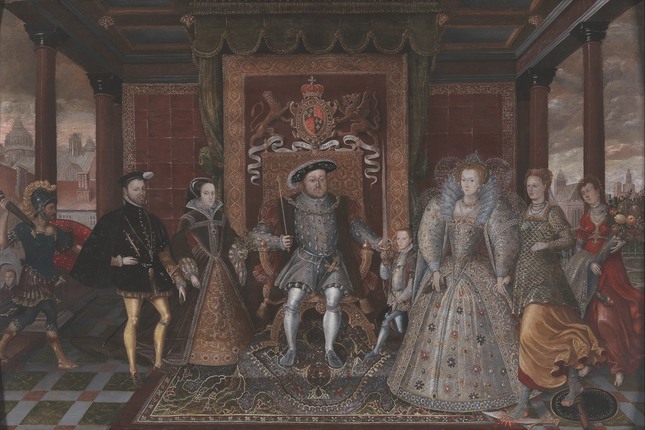
Yale Center for British Art
King Henry VIII is at the center of this painting, “An Allegory of the Tudor Succession,” but the subject is the triumph of his daughter Elizabeth I.
View full image

Yale Center for British Art
King Henry VIII is at the center of this painting, “An Allegory of the Tudor Succession,” but the subject is the triumph of his daughter Elizabeth I.
View full image
Made in the late 1590s, the twilight of the Tudor age, this painting in the collection of the Yale Center for British Art (YCBA) celebrates the triumph of Protestantism in England during the reign of Elizabeth I. The imaginary scene centers on her father—the infamous King Henry VIII—sitting on his throne beneath a canopy of state that bears the Tudor coat of arms. In his right hand he holds his scepter, and with his left he passes his sword to his son, the boy king Edward VI. To Edward’s left, his half-sister Elizabeth I is accompanied by two allegorical figures: one representing Peace, who stamps upon the sword, shield, and lance beneath her feet; the other representing Plenty, who holds the train of the queen’s dress in one hand and in the other carries a cornucopia filled with fruits and flowers—a symbol of abundance. This Protestant side of the family is contrasted with the figure of War, the companion of Henry VIII’s Catholic daughter Mary I and her husband, Philip II of Spain, who occupy the other half of the composition.
The small portrait just behind War is that of William Somers, the jester who served under all four of these Tudor monarchs. (He died in 1560.) This may have been a joke by the artist, musing on the vicissitudes of the period, which had seen control of the Church swing back and forth between Catholic and Protestant monarchs in the sixteenth century.
The painting is a piece of political propaganda, one that eschews the fact that Elizabeth I spent most of her reign at war (latterly with her brother-in-law Philip II) and ruled a nation divided along religious lines: those who conformed to the state-sanctioned Church of England and those who retained their Catholicism. In the last decades of her reign, England’s economy was damaged by crop failure and inflation. Yet the nation experienced a flowering of the arts, and moreover, it defeated the vaunted Spanish Armada.
It is not known who made this picture or for whom it was commissioned. However, the composition is derived from another work, created around twenty years earlier, that was sent as a reward by Elizabeth I to her secretary of state, Sir Francis Walsingham. That painting, now in the collection of the National Museum of Wales, does not include the figure of the jester, and it was produced by a more accomplished, Flemish-trained artist. By the time the painting shown here was finished, it was clear that Elizabeth I would not marry, and the Tudor dynasty would come to a close. This reworking of the painting made earlier in her reign has Elizabeth I triumphant: the Virgin Queen, empress, deified goddess, and mother to the nation.
The painting was acquired by Paul Mellon, Class of 1929, at auction in London in 1974 for the YCBA, where it has often been prominently displayed; for many years, it was one of the first objects encountered by those visiting the permanent collection. Ahead of the YCBA’s reopening next year (following its renovations), the painting is undergoing a major conservation treatment, which involves disassembling and realigning the boards that comprise the panel support. To that end, the painting has traveled to the Metropolitan Museum of Art in New York, where specialist conservators are carrying out work that will ensure the stability of the panel for generations. Once returned to the YCBA, the painting will be restored by Jessica David, senior conservator of paintings, in time for it to be included in a new presentation of the collection in 2025. The work will also be included in a forthcoming exhibition on Elizabethan and Jacobean painting at the YCBA, which will bring together over a decade of research into this period of British Art at the museum. It will be the first show on this subject at Yale.
 loading
loading